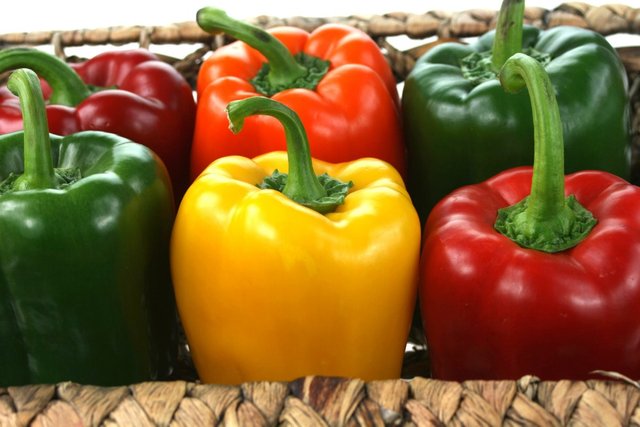THE PRACTICE OF PEPPER FARMING AND IT'S ESSENTIALS

Image from Picserver
Pepper farming is a very profitable business endeavor if you know your way around the agricultural sector. It is not expensive to start up and easy to manage.
We all know that the preferable product to deal on is something that majority of the people use daily. A very good example of this kind of product is pepper.
Before starting your pepper farming you’ll have to decide on what specie of pepper to cultivate. If you take a survey of the local market to see the kinds of pepper the traders prefer to sell, you’ll find out that not all kinds of pepper are being sold.
Here are a few that are very commonly consumed.
Bell pepper

Image from Imagespexels
Bell pepper is also known as sweet pepper, it is a mild pepper that comes in different colours, including red, orange, yellow, green and purple.
It is believed that bell pepper originated from Mexico, South and Northern America, it was later transferred to Spain in 1493 and spread to other countries in Europe, Asia and Africa.
As at now China is the world’s largest Bell pepper produced, followed by Mexico.
Cayenne Pepper
Image from pxhere CCO license
Cayenne pepper is also known as Red hot chilli pepper, it can be found everywhere it is one of the most common pepper in West Arica. Cayenne pepper can be used to relieve achy joints and muscles.
The spicy taste in cayenne pepper is as the result of the substance it is made of which is called Capsaicin, it is the active ingredient in over-the-counter treatment fot arthritis and muscle pain.
It is of good advantage that it can be stored for a long time in it’s powdered form. It can be cultivated in tropical and temperate zones which takes around 100 days to mature.
Trinidad scorpion

Image from flickr
The Trinidad Scorpion pepper was once the World’s hottest pepper in the Guinness book of records as at 2011. This pepper is commonly found in Nigerian markets has a high value.
Like all hot chilli pepper of its caliber, it is like a culinary solar flare which is not to be eaten raw or without being diluted. It can reach heats units of 1.2 million Scovile (SHU).
CULTIVATION
Moderation of water
Pepper plants need a moderate supply of water from the time they sprout till the end of the season, but waterlogged soil isn’t suitable for their roots, the soil must be a little bit porous and still be able to hold water.
Some organic matter should be introduced into the soil to enhance moisture retention and mulching is needed to minimize water evaporation from the soil during the dry seasons.
Too much fertilizers isn’t suitable for the plant, they are light feeders,
In order to attain optimum yield consider the following tips
Use plastic mulch:
Cover the early bed with a dark colored polyethylene mulch for at least a week before transplanting which will inturn heat up the soil beneath and improve the growing conditions for the young pepper plants and also help the soil retain moisture better throughout the season.
Companion planting
Here you plant two plants side by side, try planting pepperes near tomatoes, carrots.
Staking
Image from flickr
When pepper plants are laden with fruits they get easily damaged, in order to prevent damage tie the plant to sticks as support using old nylons and place the sticks firmly grounded to the soil.
In case of pests and disease plant disease-resistant pepper varieties, especially in anthracnose, mosaic, and bacterial spot are problems in your locality, and also avoid working in the garden when it’s rainy, this is because disease spread rapidly among wet pepper plants.
HARVESTING TIPS
Pepper are usually harvested at an immature stage. Early harvesting increases yields at the expense of the flavor, but allowing them to ripen before harvesting enhances flavor
Storage
For maximum flavor, eat them the day they are harvested. They shouldn’t be kept in an enclosed place including the bags in the refrigerator. They should be kept in cool and dry places.
Incase the quantity of pepper harvested are many, consider following the storage instructions below.
Drying
This method works best for thin walled hot peppers, particularly the smaller variety. Dry them slowly in order to retain their flavor and color.
But be careful of hot peppers like Trinidad scorpion, Thai dragon and Habanero they may result to blisters when handling. The chemical content that provides the heat in hot peppers, Capsaicin, is a volatile oil which can literarily burn your fingers.
Pickling
They can also be preserved b canning them. They require canning so as to retain their low acidity. You can pickle peppers like cucumbers.
Fill a crock with a simple brine of four cups of water, four cups of vinegar, and ½ cups of pickling salt. Afterwards add a clove or two of garlic and some fresh herbs for additional flavor.
Freezing
Freezing is the easiest method of storing pepper, but they’ll become soft and thawed
Reference
How to start pepper farming in Nigeria, Published in Jalingo, Accessed 21 May 2018 from
https://jalingo.co/business/start-pepper-farming-business-nigeria/
How to start pepper farming, Accessed 21 May 2018 from
https://www.wealthresult.com/agriculture/how-to-start-pepper-farming-in-nigeria
The Ultimate guide to peppers, Published 25 July 2016, Accessed 21 May 2018 from
https://www.chowhound.com/food-news/55198/know-your-peppers/
Cayenne powder, Published April 2018 in Wikipedia, Accessed 21 May 2018 from
https://en.wikipedia.org/wiki/Cayenne_pepper
Spicy Health Benefits of Cayenne Pepper, Published in RD, Accessed 21 May 2018 from
https://www.rd.com/health/conditions/health-benefits-cayenne-pepper/
Trinidad Scorpion “Butch T”: A World Of Fire, Published in Pepperscale, Accessed 21 May 2018 from
https://www.pepperscale.com/trinidad-scorpion-butch-t/
Growing Peppers, Published in Burpee, Accessed 21 May 2018 from
https://www.burpee.com/gardenadvicecenter/areas-of-interest/seed-starting/growing-peppers/article10252.html
truly, cultivating pepper doesn't really need much capital. nevertheless, there is a huge problem of deciding which one of the species to deal on, since each one of them has its own specialty.
Yea, that's true